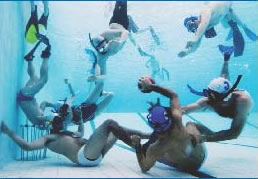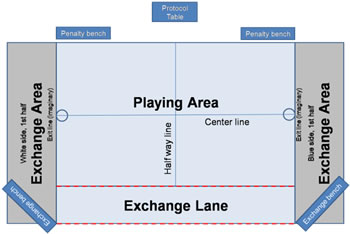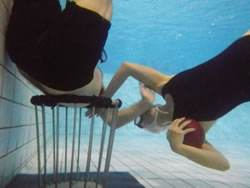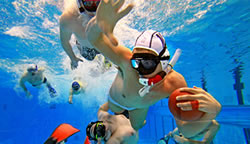The only truly three-dimensional game in the whole world
|
What is Underwater Rugby?
Underwater rugby is the only team sport in the world in which players can move in any direction they wish: up, down, sideways, left, right, diagonal, you name it. But that’s not all which is unique. The game is played under the water so you have to hold your breath. The baskets are placed at the botton of the deep end which can be up to 5 meters in depth.
Under water rugby was invented in Köln, Germany 1961 and became popular in the Nordic countries under the name, UW-Polo. Before the first Championship in 1978 the rules had to be merged (different number of players, 4 vs. 8, playing above the surface, etc). The game has since then evolved and now involved 13 counties at the latest championship.
A spokesman for the team told PutneySW15.com:
"It's physical but it's not load bearing so less likely to cause or aggravate injuries. Added to that the breath holding aspect means it's a terrific workout that helps with cardio fitness for other sports. Like traditional land based rugby it is a game where you can play to your strengths be they speed, physical strength, breath control, strategy and it's therefore a team game where men and women can play together. We've already been invited to the World Alternative Games in August next year and so we have a target for the team to focus on. "

The club meets on Thursday evenings at Putney Leisure Centre and they are looking for more players to join their ranks. Club chairman Oli Kraus said: "We're looking for male and female players, over the age of 18. There are no restrictions, all are welcome. It would be better if people can swim, we can train people to snorkel etc."
|
Tempted? Learn a little more about the sport...
Underwater rugby contests match two teams of twelve players. A team may have a maximum of 6 players in the water. The reserve players may dive in when the player they replace is fully out of the pool. The action is intense. A player usually lasts for three or four dives and then exits the pool to recover.
The teams are distinguished by suit color, either blue or white. Apart from swim suits and caps (the same kind as found in water polo), the kit includes mask, snorkel and fins. Points are scored whenever a team puts a ball in the goal, of which there are two on opposite sides of the pool in the deep end. The depth of a pool must be between 3.5 meters, the shallowest allowed by the World Underwater Federation (CMAS) rules, and 5 meters, the deepest.
Much of the action takes place entirely beneath the surface. In fact, it is against the rules for the ball to leave the water completely; it may break the surface but may not be lifted out of the water. Passing is allowed in all directions. The ball, which sinks, can only be thrust a short distances because of water resistance. Underwater rugby shares many of the same characteristics as many team ball sports on land. As in hockey, basketball or football, underwater rugby players are divided by position.
The typical modern scheme has two goalies, two forwards and two defensive backs. Generally players sharing a position take turns diving. While on defense, for example, one goalie guards the basket while the other breathes at the surface before descending to takeover goal keeping. To avoid anaerobic exertion as much as possible good team players establish a rhythm that allows them to avoid both coming up the same time for air, a lapse which often creates a dangerous goal scoring opportunity.
Each player brings his own individual package of strengths. Power, speed and agility are important. Decisiveness, will power and lung capacity set some players apart. The ability to read play requires experience. Some players excel in their ability to foresee and counteract threats. Teamwork is essential to success on both ends of the pool. This interplay of factors is one reason that men and women routinely train and even compete together.
Playing Area
There are no pools specifically designed for underwater rugby. The playing area is 12 to 18 meters long and between 8 and 12 meters wide. To delineate the playing area a line with floats is strung across the pool. Parallel to that line is another that creates the three-meter wide exchange lane, giving the substitutes a place to dive in.


Goals
The goals consist of two rigid baskets, each of which is located in the middle of its respective end of the playing area on the bottom of the pool as close to the wall as possible. The top of the basket, which is usually made of steel tubing on top of a metal base, is padded. The goals should not shift during play but sometimes do because they are not fixed to the pool bottom.
October 31, 2013
